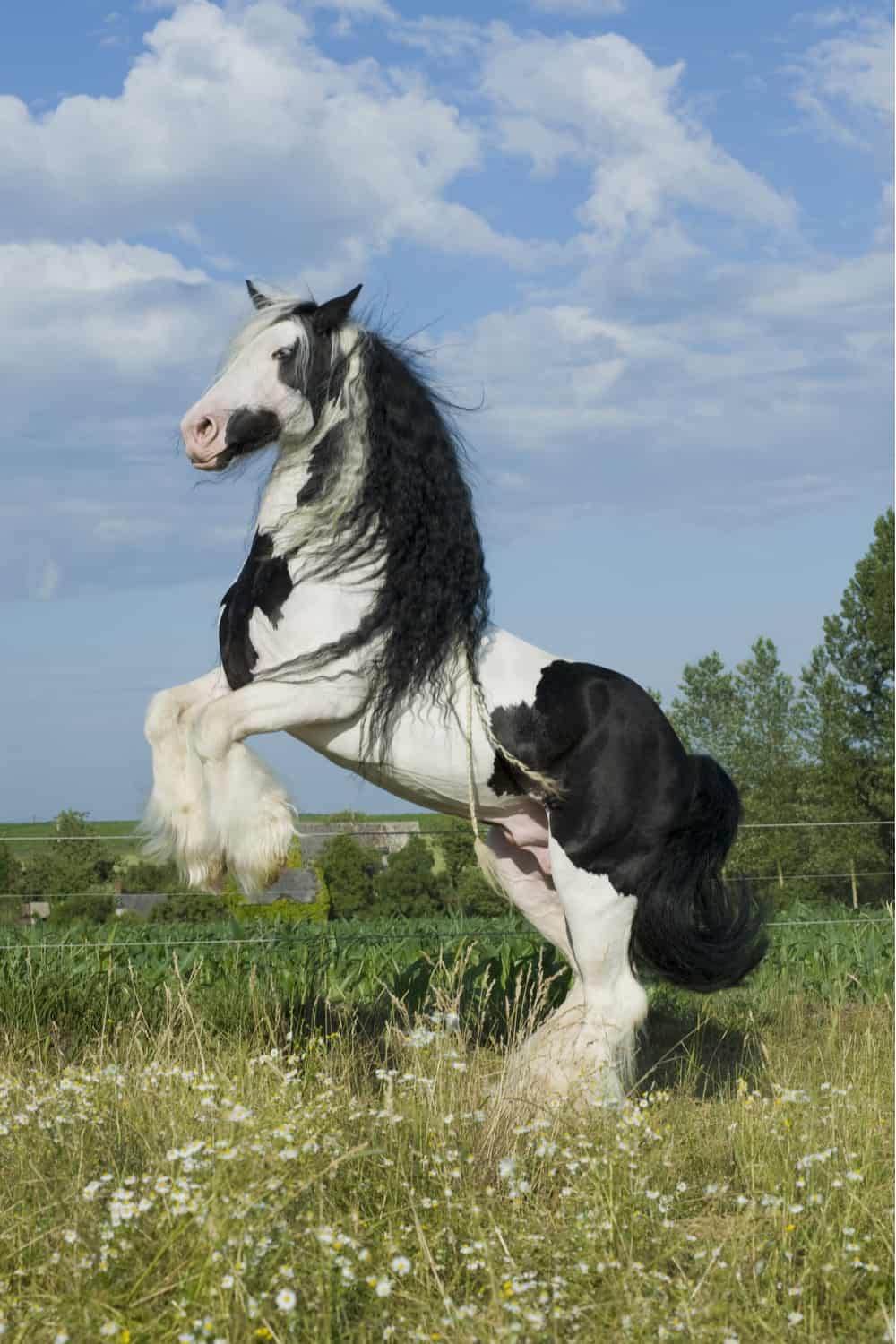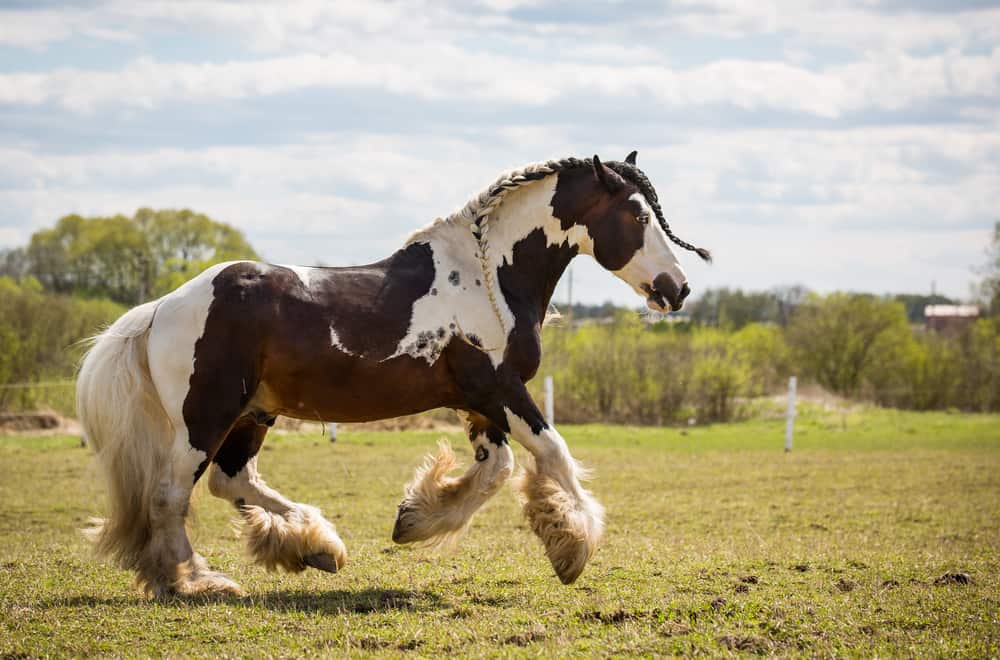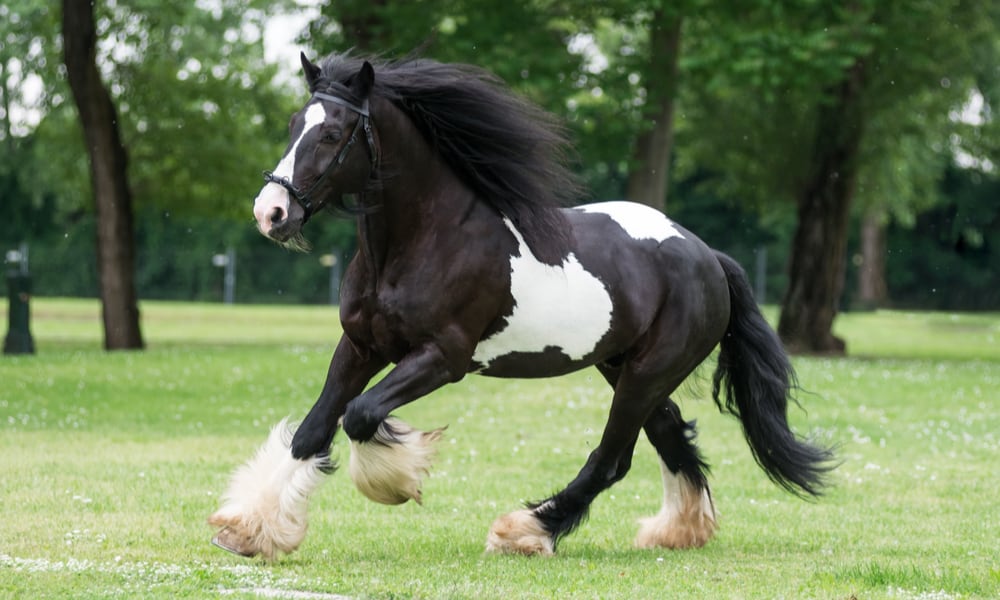The Gypsy horses (Gypsy Vanner, Galineers Cob, Gypsy Cob, Tinker Horse, Irish Cob) are traditional carriage animals. In the past, Irish Gypsies bred them as endure animals capable of covering great distances without much fatigue.
After the first Gypsy horses came to the US in the 1990s, they quickly became famous as performers in numerous disciplines. Since this playful and friendly horse breed is relatively new on American soil, many admirers wonder how much do Gypsy horses cost. Let’s see.
Gypsy Horse History

You can track the Gypsy horse origin back to Great Britain. Gypsies living there needed powerful, strong, and hardy horses to pull their caravans and make their wandering lifestyle easier. Plus, they wanted obedient family animals of good temper suitable for kids.
This horse breed’s genetic origin goes back to the Shire, Clydesdale, Dales pony, and their ancestor Friesian. Dennis and Cindy Thompson brought Bat and Dolly, the first two Gypsy Vanner fillies, to the US in 1996.
At that time, these beautiful horses weren’t recognized as a breed. Soon after, they established the first breed registry, Gypsy Vanner Horse Society.
Interestingly, the old word ‘Vanner’ used to describe a horse suitable for pulling a caravan was removed from The English Chambers Dictionary the same year when the Gypsy Vanner horse was officially established as a new breed.
Cushti Bok, the first Gypsy Vanner stallion, came to the US in April 1997, followed by Gypsy King a year later. It is possible to trace these stallions’ genetic heritage through three countries before crossing the ocean.
The Thompsons imported fourteen mares and two stallions before introducing them at Equitana USA, Louisville, Kentucky, in June of 1998. They put the new breed’s first photos on the Net soon after.
Gypsy Vanner horse breed |
|
| Features | Gypsy Vanner |
| Species | Equus caballus |
| Family | Equidae |
| Height | Typically 14 to 15 hands (56 – 60 inches / 1.4 – 1.5 m)
Can reach 17 hands (68 inches / 1.7 m) |
| Weight | 1,000 and 1,700 pounds (453.5 – 771 kg) |
| Temperament | Mild, docile, and intelligent |
| Color | Piebald, Skewbald, Tobiano, and Blagdon types |
| Lifespan | Thirty years |
| Diet | Hay |
| Care | Moderate |
| Minimal stall dimensions | 14 by 14 feet (4.25 x 4.25 m) |
| Stall set-up | Outdoor area and inside bedding |
| Compatibility | Both experienced owners and beginners |
Many other countries also established breed associations and societies, including:
Nowadays, you can notice these horses used in military parades. They are a symbol of traditional military housekeeping legacy. You can also see it in a few animation movies and the series ‘Free Rein: Bob and Heartland.’
Gypsy Horse Price

Be aware that Gypsy horse price will depend on numerous factors, including:
Bloodlines
As you can expect, bloodline plays a vital role in the horse price. An animal with an excellent pedigree will be pretty expensive. As I have already mentioned, the first Gypsy Vanners imported to North America were the magnificent Cushti Bok and Gypsy King.
These horses were foundation sires for this breed in the US. Their offspring are highly appreciated and expensive on the current market.
Age
Gypsy Vanners are widely available worldwide, but it can be challenging to find a pureblood horse, particularly in the US, where they are not particularly common. Therefore, a foal and young horse price will range from $1,500 to $4,000.
The Gypsy Vanner horse breed value |
|
| Age | Price |
| Foal | $1,000 to $1,500 |
| One to two years old horse | $1,500 to $4,000 |
| Purebred adult horse | $5,000 to $40,000 |
| Top breeding stallions | $45,000 to $60,000 |
The purebred adult animal will cost you $5,000 to $15,000, depending on age, bloodline, subtype, and training. The best quality animals can reach a price of $30,000 to even $40,000 in rare cases.
Top breeding stallions and uncastrated adult Gypsy horse males trained in shows may cost you $45,000 to $60,000.
The perfect age for this horse is between 7 and 14 years. The price of older horses will decrease significantly.
Size

The desired Gypsy horse height ranges from 13 to 16 hands (52 to 64 inches / 1.3 to 1.6 m) in the US and Australia. However, this horse type is typically up to 16.2 hands (66 inches, 1.7 m) in continental Europe and Ireland.
You can find Studbooks that include different Gypsy horse categories. For instance, the Gypsy Horse Registry of America recognizes height classifications, including:
- Purebred horses under 14.2 hands (58 inches, 1.5 m)
- Purebred horses over 14.2 hands (58 inches, 1.5 m)
- Gypsy Crossbred horses with various heights
On the other hand, the Nederlands Stamboek voor Tinkers (the Netherlands Studbook for Gypsy horses) identifies:
- Gypsy Cob with a height of 14.3 to 15.1 hands (59 to 61 inches / 1.5 to 1.55 m)
- Gypsy Vanner with a height of 15.1 to 16.2 hands (61 to 66 inches / 1.55 to 1.7 m)
- Gypsy Grai with various sizes in a range of 14.3 to 16.2 hands (59 to 66 inches / 1.5 – 1.7 m)
You can expect to pay different prices, depending on the horse size classifications.
Color

The standard Gypsy horse coat consists of irregular patches of two different colors. You can find a few common variations, including:
Piebald – Piebald Gypsy horses are the most common. They have a coat with black spots on a typically white background.
Skewbald – It is the second common Gypsy Vanner color type characteristic for white patches on any background except black. Such a horse typically has a bay, brown, or chestnut coat. Sometimes, bay and white animals are better known as tricolored.
Tobiano – This animal has a base color coat with a color pattern that includes white or pink patches.
Blagdon – This horse type has a dark-colored coat with a white pattern on a belly. It often includes numerous splashes of white over the dark surface.
The registry of horses recognizes any color and pattern since the Gypsy Vanner is a body horse type, and its color is not crucial. However, the price will significantly vary depending on the shade, and the most expensive are rare grey and palomino types.
Conformation
Conformation is a crucial factor when it comes to a Gypsy Vanner price. Ideally, this horse has a refined head, recognizably well-arched neck, powerful build, and typical feathering on its legs. The most expensive are animals that fulfill all these requirements.
Training

Gypsy Vanners are known for their energetic character, cleverness, and activeness. You can use them for riding and driving, but an average horse will require regular training. Only professionals who work with these animals at least four to five times a day can make the real winners.
Keeping the horse in shape and adequately preparing it for competitions are crucial. Since training costs are high, you can expect a trained horse to be expensive.
Show records
The primary thing is to train a Gypsy horse to be calm and attentive in shows and exhibitions since even adults act like foals and enjoy jumping. An average horse can reach over 4 feet (1.2 m) in a single jump! What a show horse!
Once the trainer teaches this animal to keep in discipline and helps it reach a high show record, it will cost approximately $25,000.
Regular Monthly Gypsy Horse Expenses
Be prepared that a Gypsy Vanner cost doesn’t include only the price of the animal itself. You should spend at least $150 to $1,000 per month for boarding and expensive food. This animal requires a specific low sugar diet because of its slow metabolism and propensity to gain weight.
Gypsy Vanner horse breed expenses |
|
| Services | Price |
| Boarding per month | $150 to $1,000 |
| Farrier once in 6 to 8 weeks | $45 and $150 |
| Yearly veterinary expenses | $300 to $400 |
| Dentistry costing once in 6 to 12 months | $80 to $250 |
| A professional grooming service | $10 to $100 |
| Training per day | $40 to $50 |
You also need to set aside $80 to $250 for dentistry once in 6 to 12 months, while a regular annual health check-up can cost you at least $300 to $400.
Daily training typically costs $40 to $50 a day, but the price depends on the trainer’s experience and reputation. Finally, be aware that this long-haired horse requires regular care. Most groomers will charge their services approximately $10 to $100.
Gypsy Horse Characteristics
A Gypsy horse is a robust, calm, easy-going, pleasing-tempered, and reliable animal from a fairy tale. It is intelligent and beautiful, and this breed’s lovers enjoy dealing with a horse that is easy to train and handle.
This breed was used to pull Gypsy caravans, but it is highly appreciated and expensive nowadays. It is ideal for trail riding, driving, and jumping. Although the price varies depending on the region, the top breeding stallions are valuable and cost at least $45,000 to $60,000.
Summary
Gypsy horses are beautiful animals that will bring happiness and joy to your life for a price of a few thousand dollars. This calm and well-behaved horse is ideal for both experienced owners and novices, but it is pricey. You should provide adequate living conditions for this animal and set aside a considerable amount of money for its care and vet bills.









Can you direct me to a farm in the United States that sells gypsy foals for under $5,000? The majority seem to be $10,000+ for foals. Dennis Thompson’s foals cost over $20,000. Thanks!
You’re smoking crack if you think you can find a Gypsy Vanner (notice capitalization…since that’s what the full-blooded ones are called and crosses cannot have that title) for less than $5,000 in the USA. Most weaned foals run $8000 minimum and up to just over $20000.
To Harry,
Wadr: Full blooded Gypsies are called a myriad of names, not just Gypsy Vanner. That term originated with the Thompsons and by anyone else. Other names, are Gypsy Horse, Tincker, Gypsy Cob and so forth. All the the latter names came from original roots in the UK. Thus, if you have a horse bread by foundation stock, not one of the Thompson offspring, they are also pure bread and well sought after. I have two such horses with foundation stock from the UK.
Also, for what it’s worth, my breeder, who only uses foundation stock transported from the Gypsy people in the UK tells me that they do not use the word vanner in association with their horses. That term, for them, refers to a garbage truck. The wagons the Gypsy people use are called Vardos, not vanners. They regard their horses as much a work of art at their hand-painted vardos and find the term offensive.
To Kay, I agree with Harry regarding the price. My two were $8000 a piece as foals.
Hi Everyone,
I am Sascha Shamkin and I have multiple very high functioning mental disorders and am looking for a gypsy vanner to help me with my unique challenges that I face on a daily basis.
I am looking for a cheap as possible 10 year old or older but not a senior per breed gypsy vanner for my first ever horse.
I don’t plan on ever riding my gypsy. So I am okay with one that can only do ground work and liberty work.
I would prefer a gypsy vanner that has long white main, forlock, feathers, and tail, with black body with pur white spots. Or a blue roan with black main, forlock, feathers, and tail.
I would also like one with very bright light blue eyes.
I will not only except a gypsy with these colors. I will expect any gypsy.
Preferred temperament would be a 0 to 3 on the numbering scale.
If anyone could direct me to a gypsy vanner horse ranch that has a 10 year old or older but not a senior I would greatly appreciate it.
If you can please include address of the ranch, phone number, and email address. As well as photos, videos, and prices of available gypsies I would greatly appreciate it.
Have a great and blessed day,
Sascha Shamkin